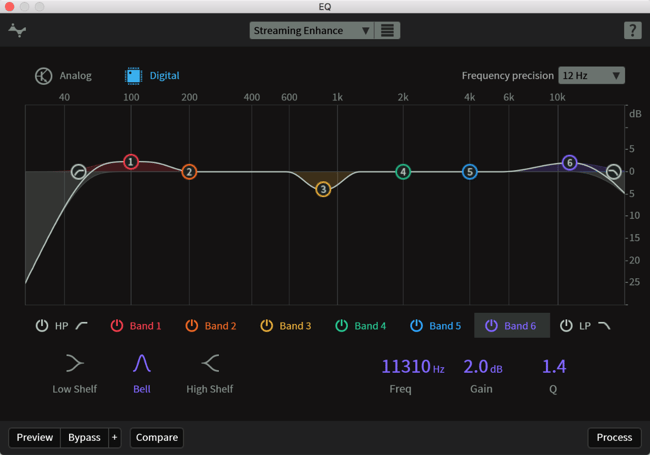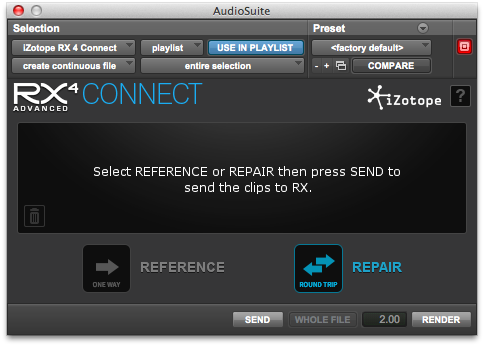- Izotope Rx Rapidshare
- Izotope Rx Torrent
- How To Use Izotope Rx With Pro Tools Free
- Izotope Rx Tutorial
- How To Use Izotope Rx With Pro Tools Reviews
Here is our very own “Mr RX It” showing in another free video tutorial, courtesy of iZotope, how to use the iZotope RX3 Spectral Repair plug-in in Pro Tools. In self shot documentaries the sound is often the thing that suffers, as the crew have too many other things to think about. If you find unnecessary sounds, use an EQ to cut them and remove any problematic frequencies. You could also use specialized audio repair tools such as iZotope’s RX to isolate vocals from a song. Demo Song Examples. These recordings are a cover of ‘House of the Rising Sun‘ made famous by The Animals. May 04, 2015 Learn how to use iZotope's RX Loudness Control as an offline process within Avid Pro Tools to make your completed mix broadcast compliant. Download your free, 10-day trial: www.izotope.com.

Here is our very own “Mr RX It” showing in another free video tutorial, courtesy of iZotope, how to use the iZotope RX3 Spectral Repair plug-in in Pro Tools.
In self shot documentaries the sound is often the thing that suffers, as the crew have too many other things to think about. In this example we suspect that the camera operator just didn’t hear the siren in the background on the best take so we are left to fix it in post.
See how Mike was able to improve it using the RX3 Spectral Repair plug-in without having to leave Pro Tools so speeding up the workflow.
RX3 and RX3 Advanced are on special offer until 1st May 2014. Check out the offers available from our friends at Time+Space or you can buy direct from iZotope.
In this video, I’m going to cover how to use the brand new De-Bleed module in RX 6 in a music production context using a vocal sample.Once you’ve downloaded the test files, one called “Vocal Production_Active Bleed” and the other, “Vocal Production Click Track (Source)” for the tutorial from the RX web page and opened it in RX by clicking and dragging them into the RX application window, or by opening RX and pressing Command+O or Control+O on a PC, your RX window should look like mine, with the files, “Vocal Production_Active Bleed” and “Vocal Production Click Track (Source)” side-by-side in tabs on the top-left hand side of the screen.

So, De-Bleed reduces the leakage of one signal into another, such as when vocals bleed into a guitar microphone, or when a click track is fed into headphones, and then that bleeds into an open mic, and that’s exactly what I have here for this sample.
So in the recording I’m about to play, we’re going to hear a male vocal that has a faint clicking sound on it. Let’s see if you can hear it.
[vocal sample with click bleed]
So to reduce the sound of the clicking that we’re hearing, I’m going to use the De-Bleed module. I just want to point out one thing before I do though, and that’s if I slide this back to the waveform and spectrogram view, we can’t really see those clicks, can we? In fact, if I go all the way to the x-axis here, we just see the waveform. I can’t see those clicks, but if I slide all the way over to the spectrogram view, I can see them. They’re sort of perforated going up and down the screen. There’s one very pronounced here on the right, so it’s a really handy thing to be able to visualize audio in this way to be able to see and detect those clicks.
So let’s get on to the De-Bleed module. I’ll find that up here, it has a little microphone next to it. So there’s a few things to remember before using De-Bleed. The first is that it requires two files, a source and an active file to be open in the RX audio editor.
Now, we’ve already done that, right? We have our active bleed track here, and our vocal production click track source side by side.
Izotope Rx Rapidshare
The next thing is that the sample rate of the source and active files must match. If they don’t, that’s okay, we can use the resample module right here to correct the sample rate differences between the files.
The next thing is that the De-Bleed source and active files must be time aligned within a few milliseconds of each other, and this means that if the two audio files were played back together, they would sound in sync, so if the same audio events are occurring at the same points in the timeline for both the source and active tracks, this means they’re time aligned.
If the two tracks aren’t synchronized to within a few milliseconds of each other, we can cut out part of the track or add silence to a track to put the two tracks in sync with each other. We can adjust the length or timing of the files, for example, by using the cut edit operation, so I’ll click and drag to show you. I can go Command+X or Control+X on a PC to cut that file. I’ll Command+Z to get back. Control+Z on a PC. Or I can insert silence using the signal generator down here to adjust the length of the file.
Now let’s go into the De-Bleed module and learn a little bit about it. So I want to make sure that my active track, the name that’s displayed here, Vocal Production_Active Bleed is the one I want to attenuate the bleed from. In this case, it is, right? I played it a moment ago. This is the one that has the vocal and the click track on it. Have a listen.
[vocal sample with bleed]
So that’s good.
The next thing I want to make sure is that the source track from the source track dropdown menu is indeed the click source. In other words, we’re being asked where the bleed is coming from. In our case, that’s the click track, which is this track right here. I’ll play a little bit of that.
[click track]
So now, I’ll return to my active bleed tab. So now, in the active file tab, which is the tab that I’m on right now, we have to make a selection as to where the bleed is most obvious. In my case, the bleed occurs throughout the vocal, so I’m going to click Command+A or Control+A on a PC to highlight the entire track.
Next, I’ll click the learn button in the De-Bleed module. This analyzes the general relationship between the bleed source and the active track.
After a learned pass is complete, we can process the track with a couple of parameters here. Let’s go through them.
The reduction strength control determines the amount of bleed reduction applied during processing. So I don’t want to push this too hard, in case it might eliminate audio I want to keep from the active track, so I’ll keep it at its default setting of one.
Artifact smoothing can help to reduce or eliminate the under-watery sort of noise that we might incur from the processing that powers the De-Bleed module. Again, I’m going to leave it here at its default setting of five and make changes if I need to after I’ve pressed process. And speaking of which, let’s process.
Izotope Rx Torrent
Let’s hear the results of our processing with the De-Bleed module.
[vocals after processing]
I can’t hear the click track at all. Let’s go back to the before just for context. So here is before we used the De-Bleed module to attenuate that click.
[vocals before processing]
How To Use Izotope Rx With Pro Tools Free
And here’s after we used De-Bleed.
[vocals after processing]
Izotope Rx Tutorial
The differences there are pretty dramatic.
How To Use Izotope Rx With Pro Tools Reviews
So for more information and to download your own samples to use with RX 6, visit izotope.com/RX.